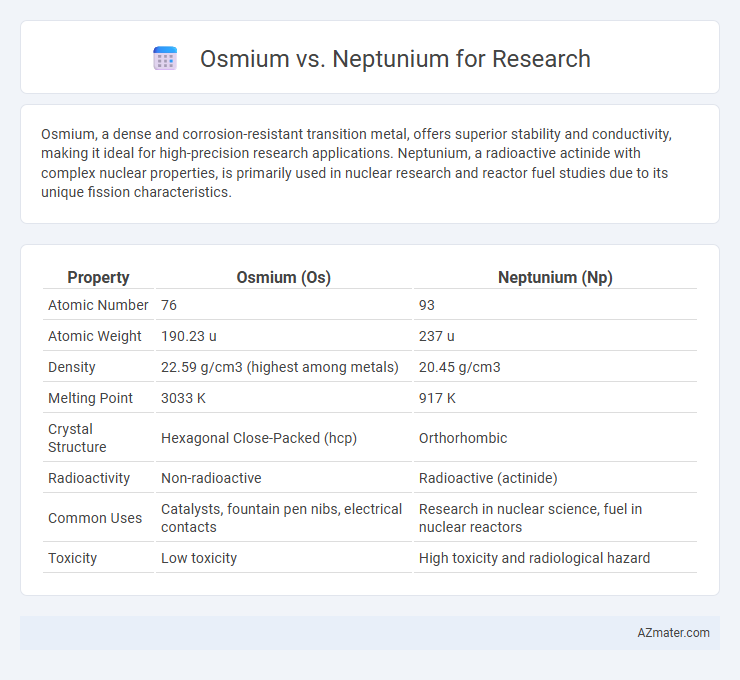Osmium, a dense and corrosion-resistant transition metal, offers superior stability and conductivity, making it ideal for high-precision research applications. Neptunium, a radioactive actinide with complex nuclear properties, is primarily used in nuclear research and reactor fuel studies due to its unique fission characteristics.
Table of Comparison
| Property | Osmium (Os) | Neptunium (Np) |
|---|---|---|
| Atomic Number | 76 | 93 |
| Atomic Weight | 190.23 u | 237 u |
| Density | 22.59 g/cm3 (highest among metals) | 20.45 g/cm3 |
| Melting Point | 3033 K | 917 K |
| Crystal Structure | Hexagonal Close-Packed (hcp) | Orthorhombic |
| Radioactivity | Non-radioactive | Radioactive (actinide) |
| Common Uses | Catalysts, fountain pen nibs, electrical contacts | Research in nuclear science, fuel in nuclear reactors |
| Toxicity | Low toxicity | High toxicity and radiological hazard |
Introduction to Osmium and Neptunium
Osmium, a dense transition metal in the platinum group, is prized in research for its extreme hardness and high corrosion resistance, making it valuable in materials science and catalysis studies. Neptunium, an actinide element, plays a crucial role in nuclear research due to its radioactive properties and position as a byproduct of uranium and plutonium decay. Both elements offer unique chemical and physical characteristics that drive innovation in their respective fields, with osmium focusing on industrial applications and neptunium on nuclear chemistry and waste management.
Chemical and Physical Properties Comparison
Osmium, a dense transition metal with a high melting point of 3033degC and a bluish-silver appearance, exhibits exceptional hardness and corrosion resistance, making it valuable in catalysis and material science research. Neptunium, a radioactive actinide with a melting point of 637degC, is chemically reactive and primarily studied for its complex oxidation states and nuclear applications in actinide chemistry. Comparing their chemical properties, osmium is stable under standard conditions with oxidation states ranging from -2 to +8, whereas neptunium's variable oxidation states (+3 to +7) enable diverse redox reactions critical for nuclear fuel cycles and environmental remediation research.
Occurrence and Extraction Methods
Osmium, a dense platinum-group metal primarily found in platinum ores, occurs mainly in the mineral osmiridium and is extracted through a complex process involving crushing, milling, and chemical treatment to separate it from other platinum-group elements. Neptunium, a radioactive actinide element, is synthetic and produced as a byproduct in nuclear reactors through neutron capture by uranium-235 or uranium-238, making its occurrence rare in nature. Extraction of neptunium involves advanced nuclear reprocessing techniques, such as solvent extraction and ion exchange, to isolate it from spent nuclear fuel for research purposes.
Applications in Scientific Research
Osmium, a dense transition metal, is extensively used in scientific research for its catalytic properties and applications in microscopy, especially as a staining agent to enhance electron microscopy imaging resolution. Neptunium, a radioactive actinide, plays a critical role in nuclear science research, including studies on nuclear fuel cycles, radioactive waste management, and actinide chemistry. Both elements contribute uniquely to scientific advancements, with osmium supporting material science and microscopy innovations, while neptunium advances nuclear chemistry and radioactive material handling technologies.
Safety and Handling Considerations
Osmium, a dense transition metal, poses handling challenges due to the toxic osmium tetroxide it can form upon exposure to air, requiring stringent ventilation and protective equipment in research settings. Neptunium, a radioactive actinide, demands rigorous radioactive material protocols including specialized containment, monitoring for radiation exposure, and compliance with nuclear regulatory standards. Researchers prioritize osmium's chemical toxicity control and neptunium's radiological hazard mitigation to ensure safe laboratory conditions.
Radioactive Properties and Implications
Osmium is a dense, stable transition metal with negligible radioactivity, making it suitable for applications requiring minimal radioactive interference. Neptunium is a highly radioactive actinide with multiple isotopes exhibiting alpha decay, posing significant handling and safety challenges in research. The intense radioactivity of neptunium necessitates specialized containment and impacts experimental design, whereas osmium's stability benefits studies focused on non-radioactive heavy metals.
Cost and Availability for Laboratories
Osmium, a rare platinum-group metal, is significantly more expensive and less abundant than neptunium, posing challenges for laboratories with limited budgets. Neptunium, a radioactive actinide primarily obtained as a byproduct of nuclear reactors, is more accessible due to its nuclear industry sources, though handling costs are elevated by stringent safety protocols. Cost-efficiency and availability make neptunium a relatively practical choice for specialized nuclear research, whereas osmium's rarity and high cost restrict its use to niche applications in catalysis or materials science.
Environmental Impact and Disposal
Osmium, a dense and rare transition metal, poses significant environmental risks due to its toxic osmium tetroxide compound, which requires careful handling and disposal to prevent air and water contamination. Neptunium, a radioactive actinide found in nuclear waste, demands stringent containment to avoid long-term radiation hazards and bioaccumulation in ecosystems. Research on safe disposal methods prioritizes immobilization techniques for neptunium and advanced filtration systems for osmium compounds to mitigate their ecological impact.
Advances in Research Using Osmium
Osmium has emerged as a critical element in advanced materials research due to its exceptional density and hardness, facilitating innovations in catalysis and nanotechnology. Recent studies have leveraged osmium's unique electronic structure to develop highly efficient catalysts for oxygen reduction reactions, significantly impacting fuel cell technology. In contrast, neptunium research remains largely confined to nuclear science, with limited applications outside radioactive material studies.
Future Prospects of Neptunium in Research
Neptunium holds significant promise for future research due to its unique radioactive properties and potential applications in nuclear fuel cycles and waste management. Unlike osmium, which is primarily valued for its corrosion resistance and industrial uses, neptunium's role in advanced nuclear reactors and transmutation processes positions it as a critical element for sustainable energy solutions. Ongoing studies focus on harnessing neptunium's isotopes for improving the efficiency of nuclear waste recycling and exploring its behavior under various radiation conditions to enhance reactor safety and performance.

Infographic: Osmium vs Neptunium for Research
 azmater.com
azmater.com